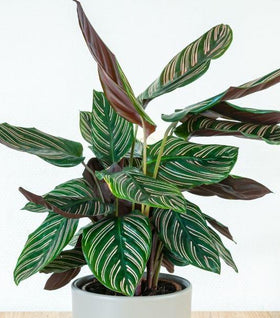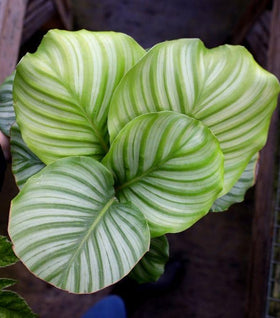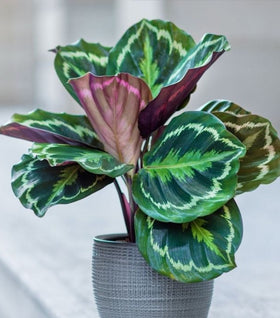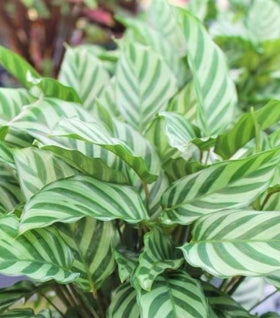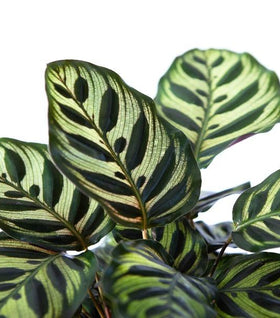Calathea Plants for Sale Online
Calathea Plants, also known as cathedral windows, peacock plants, prayer-plants, or zebra plants, are among the most popular house plants sold today. Their beautiful leaves display bright green, white, red, and cream shades and have unique textures that add interest to any decor. They are easy to care for and a great starter plant for new house plant growers.
Calatheas are beautiful houseplants that can bring a tropical feel to even the smallest apartment or office. The tops of the leaves are often striped, and the undersides typically are a lovely shade of burgundy purple. There are many different varieties of calathea available today.
Buying Calatheas Online
The Calathea plants' ornate foliage creates a significant impact when grown indoors as an element of living home décor. Calathea can ultimately grow to heights of 2.5 to 3 feet, but they are very slow growers and have a bit of a reputation for being high-maintenance houseplants. With the proper Calathea care regimen and conditions though, these stunning tropical plants can be quite simple to care for.
Calathea is part of the Prayer Plant family, which is a genus of plants from tropical areas of the world, loved for their ability to open and close their leaves, mimicking praying hands. This family of plants is also well-known for bold colorful leaves and unique foliage patterns that appear so intricate they almost look hand-painted. Typically found in jungles and at the base of trees, Prayer Plants are simple to care for given you replicate their tropical home environments.
They have adapted in the wild to thrive in low light, making them perfect for office buildings or apartments with north-facing windows. Some popular selections within this captivating genus of plants include Calathea Ornata, Calathea Makoyana, and Calathea Medallion. Each plant basting unique shapes and sizes of green leaves and captivating patterns
Tips for growing Calathea
Calatheas have been given a bad rep for being finicky and high maintenance. If you follow these simple guidelines to Calathea care, you will be able to master growing these exotic and beautiful indoor plants.
Ideal lighting for a Calathea includes medium to bright indirect light. Because these plants originate from the jungle floors, they are often covered by canopies of leaves, so they will easily adapt to being a low-light plant as well. Calatheas do not like the bright sun on their leaves, so place them away from the direct sunlight to prevent sunburn.
While Calatheas do prefer moist soil, they do not tolerate wet or saturated soil. To properly water a Calathea, we recommend watering when the top inch of the soil is dry. It is essential that you pot your trendy tropical plant in well-draining potting soil. We recommend Espoma Organic Potting Mix. Additionally, it is important to pot your plant into a pot with drainage holes to allow excess water to drain.
Calathea do not enjoy the added minerals found in tap water, so to avoid any plant stress, one should opt for purified or distilled water.
Because these plants have tropical origins, it is only natural that they enjoy high moisture and humidity levels as well. Extended periods of dry soil and air can result in leaves with brown edges and drooping, crispy foliage.
As a tip to increase a plant's overall humidity level, we would recommend using a pebble tray beneath your potted plant. To create a pebble tray, simply place your plant in its pot on top of a plate with rocks and a little bit of water. The water will rise and evaporate into the air around your tropical plant, ultimately increasing the overall humidity.
As with any living plant, you will need to feed your Calathea to keep them vibrant and happy. Feed your Calathea plants with a slow-release fertilizer such as Osmocote Plus indoor/outdoor fertilizer in the growing seasons of spring and summer. If you prefer to feed as you water, we recommend Jack's Classic Houseplant special plant food. However, there are endless types of houseplant fertilizers available today, and if you have one, you are comfortable staying consistent.
It is important to note that Calatheas are indoor plants and should not be left outside during the late fall through spring. We do not recommend planting Calathea outdoors unless you live in zones 11 and 12.
For more detailed care instructions, please see our Calathea Growing Guide.
Frequently Asked Questions About Calathea
Are Calathea Plants Safe For Pets and Children?
Yes, Calathea Plants are safe for Pets by the ASPCA. For other pet-safe plants, visit our collection Pet Safe House Plants. Calathea plants are also non-toxic to children making them a fun and colorful way to introduce children to the world of tropical plants.
Which is the Easiest Calathea for Beginners?
Calathea Lancifolia is also known as Rattlesnake Plant. This narrow-leafed Calathea is considered by many enthusiasts to be the easiest in the family. Not only is this plant easy, but it's also one of the most colorful of the family.
Why are the leaves of my Calathea Curling?
Calathea leaves curling can be a sign of improper watering and is a mechanism the plant uses to reduce water loss. Leaf curling is most commonly due to underwatering, low humidity levels, or excess sunlight, but can also happen due to root damage caused by root rot, overfertilizing, or disease.
Calathea plants like to move their leaves. A healthy Calathea will slowly turn its leaves to catch ambient rays of sunshine and this should not be confused with leaf curling. An unhealthy Calathea will curl its leaves to let you know it's in distress. Once you fix the problem, the leaves will unfurl.
If the leaves are curling here are a few things you can do to help the plant:
Move the plant out of the direct sunlight. Calathea do not like direct sunlight. Too much sun can permanently damage the leaves. Move the plant away from the window, but make sure that there is still indirect light available to the plant.
Are Calathea Air-Purifying Plants?
Calathea is a top NASA-approved air purifying plant that removes indoor Volatile Organic Compounds (VOCs) like formaldehyde, benzene, and other air toxins. You can rest easy when surrounded by Calatheas that the air you're breathing is as clean as it can be.


